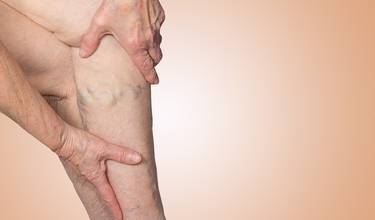Having swollen legs and ankles is not uncommon, and often, it is not a sign of a severe acute condition. However, if the reason for the swelling is deep vein thrombosis, the situation is more serious with potentially severe consequences, and for this reason, recognising the signs and symptoms of DVT is highly useful. DVT can occur in people of all ages, whether young or old, fit or untrained, and anytime of the day regardless of activity. It can develop in blood vessels everywhere in the body. DVT typically occurs when the blood moves too slowly through the veins, and the so-called coagulation factors initiate the coagulation cascade (blood clotting), which causes platelets to stick to each other thus forming a clot which stops the blood flow.
The risk factors include:
- Thrombophilia – a disease that increases the risk of thrombosis
- Inactivity – for instance due to immobility, old age, bone fractures, illness, long flights or drives
- Surgery – the risk is higher directly after the procedure
- Taking birth control pills or going through hormone therapy
- Smoking
- Pregnancy and the first six weeks after giving birth
- Certain diseases and conditions might increase the risk: Paralysis, stroke, chronic heart disease, raised blood pressure, surgery or recent cancer treatment.
Everybody, especially those at high risk, can benefit from reducing their risk of DVT by familiarising themselves with these simple tips to prevent DVT and the potentially dangerous consequences:
- During long trips where you sit for long periods of time, it is a good idea to stand up and move around from time to time, so the blood doesn’t pool in your veins
- After surgery, it is important to get out of bed as quickly as possible
- Use compression stockings
- If necessary, your doctor can prescribe medication which helps prevent blood clots
- An early diagnosis of thrombophilia – this is however rare, as thrombophilia is often discovered when a patient has an episode of DVT
- Give up smoking
The symptoms of DVT include swelling, pain, redness and a feeling of warmth in the affected area. However, as many as 40 % of DVT cases go unnoticed because the blood clot does not cause any symptoms or because the body’s protective mechanisms quickly dissolve the clot, thus preventing the harmful consequences of DVT.
What is particularly dangerous about DVT, especially in the thigh, is that a piece of the blood clot can break off and travel with the blood through the large veins towards the heart and into the pulmonary circulation system. Here, the clot passes through the small vessels until it becomes too big to pass thus forming a blood clot in a pulmonary artery, also known as a pulmonary embolism. A blockage of a pulmonary artery can have fatal consequences, as it damages the tissue of the lung and reduces oxygenation of the blood supplied to the rest of the body. Thus, other organs will be damaged by the pulmonary embolism as well.
If you experience any of the symptoms mentioned above, it is important to contact your doctor immediately. Your doctor will be able to determine whether DVT is the cause of your symptoms, and which treatment is needed to dissolve the blood clot as quickly as possible.








